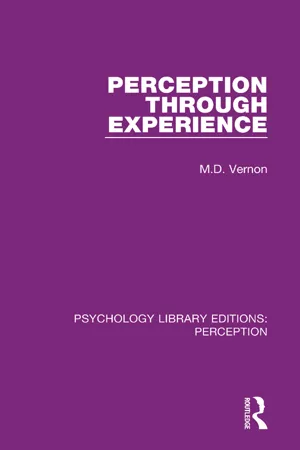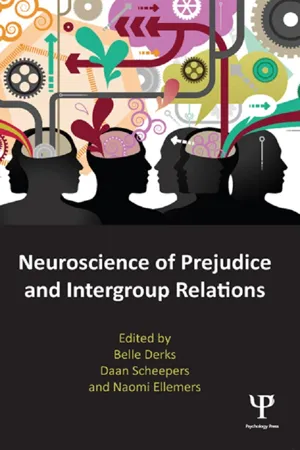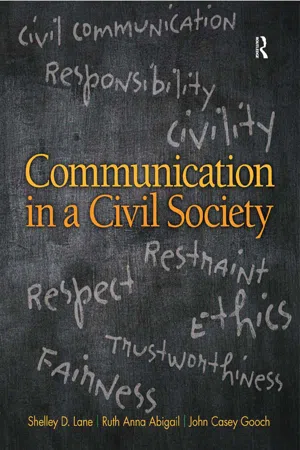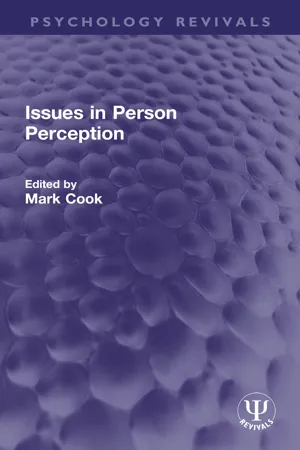Psychology
Person Perception
Person perception refers to the process of forming impressions and making judgments about other people. It involves interpreting and understanding the characteristics, traits, and behaviors of individuals based on available information. This process is influenced by factors such as social norms, stereotypes, and personal experiences, and it plays a crucial role in social interactions and relationships.
Written by Perlego with AI-assistance
Related key terms
11 Key excerpts on "Person Perception"
- eBook - ePub
Social Interaction
Process and Products
- Michael Argyle(Author)
- 2017(Publication Date)
- Routledge(Publisher)
IV Perception of the other during InteractionIntroduction and Methods
Person Perception has been extensively studied in recent years, and several good accounts of this work are available (e.g. Tagiuri, 1969; Smith, 1967). Much of the research has taken Person Perception as a primarily cognitive problem, rather akin to concept-formation or problem-solving - and of course these processes are important here. In this chapter we will look instead at Person Perception as something that happens during social interaction, and which is a very important part of such interaction. Thus we shall be concerned with what perceptual information is needed by an interactor, how it is obtained, and the fact that the 'judge' is simultaneously being perceived by the other person. We shall also broaden the range of perceptual data beyond facial expression, which has often been the object of research in this field, to include tones of voice, and the whole range of verbal and non-verbal behaviour discussed in the last chapter. The term 'perception' is used here in somewhat different sense from the way it is used in experimental psychology. We are not concerned with whether A perceives B to be short or tall, dark or fair, but with A's inferences about B's personality, emotional state, attitudes to himself, and so on. In other words we are concerned with inferences about another person based on his visible or audible behaviour.The perception of persons is a more complex matter than the perception of other physical objects, since the sensory inputs are normally obtained as part of the process of interaction; there are two main channels of information, visual and auditory, and both are open intermittently - the other speaks for only part of the time, emitting verbal and non-verbal noises, and the judge can look for relatively short intervals. Inferences are made because they are needed by each interactor, and the kind of inferences made depend on the situation and the relationship between the interactors. The other person is seen, not only as an object of perception, but as another centre of conscious experiences and intentions and as a perceiver himself. - eBook - ePub
Job Feedback
Giving, Seeking, and Using Feedback for Performance Improvement
- Manuel London(Author)
- 2003(Publication Date)
- Psychology Press(Publisher)
(For an in-depth review of this literature, see London, [1995a], chapters 3, 4, and 6, and London, [2001], chapters 1 and 2.) I consider the cognitive processes people use to encode, store, and decode information before giving feedback. Also, I show how rater motivation, observation skills, information distorting biases, and empathy for others influence rater accuracy. I begin by turning to the basic psychological and cognitive processes that underlie evaluations—a field called “Person Perception.” Person Perception Theory and Research The social psychological processes of Person Perception explain how managers form impressions of others and use this to provide them with feedback about their job performance. Person Perception refers to the processes by which we form impressions and make inferences about other people in response to the behaviors, words, and interactions we observe between ourselves and others and between other people (Klimoski & Donahue, 2001). This occurs over time and culminates when one person (e.g., a manager) is asked to evaluate another (e.g., a subordinate or peer). The evaluation is likely to be subject to a number of factors that affect the accuracy and usefulness of the judgment for the purpose at hand. Klimoski and Donahue (200 1) argued that Person Perception incorporates various levels of analysis, including the perceiver, the person(s) perceived, the relationships between them, and the situation. The perceiver's goals, motivation, and cognitive skills and processes need to be considered. Also, the perceiver is an active participant in the process, interacting with the individual evaluated, thereby inducing behaviors that then are incorporated into the perception and the favorability of the resulting judgment. The way we perceive others may be influenced by expected patterns of behaviors, called scripts or schemas. These are well-learned behavioral sequences that define typical reactions to environmental conditions (Abelson, 1976) - eBook - ePub
- Nicky Hayes(Author)
- 2017(Publication Date)
- Routledge(Publisher)
Liking and attraction, though, are to do with our personal reactions to individuals. Sometimes we don’t even get as far as seeing the individual, because of prejudice towards their social group. So in this chapter, we will also explore some of the different types of social prejudice, and how they may be challenged in modern society. Prejudice isn’t the same as aggression, of course, but in its extreme form it can certainly produce aggressive behaviour towards other people. There have been many theories developed to explain aggression, and we will look at some of these, and at some of the most common ways that aggression manifests itself in modern society. But we’ll begin our investigations by looking at how we perceive other people.Person Perception
Understanding how we see other people is an important part of understanding our social nature. But we don’t see people directly — as the Tardis said when she took on a human incarnation in the TV series Doctor Who: “Are all people like this? So much bigger on the inside?” (BBC, 2011)We don’t see directly into people’s minds. What we actually see of other people is the outside, and what it communicates to us. As we saw in Chapter 3 , people communicate in many different ways, both consciously and unconsciously, and the contexts in which they are interacting with us also varies. Which means that the process of perceiving other people brings together a lot of different factors, some of which come from the person themselves, and some of which come from our own ideas, assumptions, and personal constructs.The study ofPerson Perceptiondeveloped in the 20th century, and social psychologists identified a number of different mechanisms involved in how we form impressions of other people. We will look briefly at six of these mechanisms: implicit personality theory, stereotyping, the self-fulfilling prophecy, personal constructs, primacy effects and halo effects.Implicit personality theory
A considerable amount of psychological research has been devoted to teasing out the implicit knowledge and principles which we use in forming impressions of other people. In 1946, Asch showed how we tend to go far beyond the data available, applying our own implicit theories of personality to what we see of the other person. These theories, although unique to each person, have some characteristics in common; for example, we tend to expect people who show one or two of them to show related traits as well. And we regard some personality traits as more central, or important, than others. - eBook - ePub
- Kelly G. Shaver(Author)
- 2016(Publication Date)
- Routledge(Publisher)
2 The Foundation of Attribution: Person PerceptionWe have seen that perceivers are active participants in the perceptual process: they try to explain and predict human behavior through processes described by attribution theory. At this point you may wonder just where attribution fits in the larger context of social psychology. Is it found in phenomena of socialization? Attitude change? Group dynamics? A case can be made for the importance of attribution in all of these areas, but historically attribution theory is most closely identified with social perception. The basic data for any attribution are, after all, the actions of persons, so in both approach and method, attribution theory has developed out of the area of social psychology known as Person Perception. You will probably find it easier to understand attribution theory if you are familiar with some of the traditional concerns of Person Perception, such as models of the process, descriptions of the stimulus, and actions of the person that contribute to the perceiver's impression. Accordingly, this chapter summarizes major elements of Person Perception. Comprehensive review is beyond the scope of this book; advanced students are referred to detailed discussions by Taguiri and Petrullo (1958) and later by Taguiri (1969).Social Perception as a Lens of the World
Whether the stimulus for perception is an inanimate object or another person, the result of the perceptual process can be defined, following Allport (1955), as "a phenomenological experience of the object, that is to say, the way some object or situation appears to the subject . . ."(p. 23). It is assumed by this definition that an objective reality which contains both things and people exists outside the perceiver. To indicate that these physical and social objects are remote from the perceiver and cannot be directly experienced by him, they are referred to as distal objects. After some appropriate kind of mediation—light waves, sound waves, physical contact—a distal object will become represented at the perceiver's peripheral sense organs. The light waves produce an identifiable pattern on the rods and cones in the retina of the eye, the sound waves stimulate a particular pattern of response by various elements of the inner ear, and the physical contact gives rise to a pattern of response from receptors in the skin that are sensitive to pressure and temperature. In each case, the resulting pattern of stimulation of receptors is called the proximal stimulus - eBook - ePub
- F. Heider(Author)
- 2013(Publication Date)
- Psychology Press(Publisher)
The particular behavioral data on which the judgments or perceptions of the other person’s wishes, abilities, or traits are based are not mentioned. One may even feel that the description of the essential interpersonal process would not gain very much in exactitude if they were specified. Neither would a more detailed report of A ’s particular actions change very much our understanding of the main features of the event. The particular action by which A benefited B is of importance only insofar as it is judged by B and is related by him to his self-evaluation. To be sure, we might describe the event by concentrating on the surface, on the overt behavior, on what can be seen from the outside. But even then the reader would certainly translate the overt syndromes into concepts very much like the ones used in the description given above. These concepts provide the nodal points in terms of which the event can be described most economically, which allow for extrapolation to other possible events and which allow for prediction. Social perception in general can best be described as a process between the center of one person and the center of another person, from life space to life space. When A observes B’s behavior, he “reads” it in terms of psychological entities (and his reactions, being guided by his own sentiments, expectations, and wishes, can again be understood only in terms of psychological concepts). A, through psychological processes in himself, perceives psychological processes in B. Asch has clearly expounded this view in the following: The paramount fact about human interactions is that they are happenings that are psychologically represented in each of the participants. In our relation to an object, perceiving, thinking, and feeling take place on one side, whereas in relations between persons these processes take place on both sides and in dependence upon one another… - eBook - ePub
- M.D. Vernon(Author)
- 2017(Publication Date)
- Routledge(Publisher)
X The Perception of Persons (1) Introduction There is one perceptual schema, or more probably a set of related schemata, which differs very considerably from those which we have already discussed, related to form, inanimate objects, verbal material, space and movement: the schemata which are associated with the perception of people, their emotions and their actions. It seems clear that from their earliest years children perceive other people, their faces and their behaviour, in a manner peculiar to this category of percepts, and that special schemata are evolved within which these percepts are integrated. The main peculiarity of these is that observers are usually aware only to a minor extent of the details of physical characteristics presented by the appearance and behaviour of other people, and are concerned mainly with their intentions, their emotions and their personality characteristics. Such inferences appear so early in life that certain psychologists, such as Werner (1948), suppose that there is an innate tendency for what has been called ‘physiognomic ’ perception; that is to say, to perceive the dynamic properties of objects, as well as of people, as characterized by a special type of causality, such as that which is involved in human motivation. Indeed, we may note that children tend to classify all moving objects as living, and as having intentions to perform specific actions. Heider (1958b) also pointed out that the stimulus patterns involved in the perception of persons were more complex and extensive than those on which perception of objects was based; the former gave rise to actions embedded in a whole sequence of events (though of course this may occur with inanimate objects also). From early infancy, previous knowledge and expectations as to the actions and motives of people are obviously highly significant to us - Belle Derks, Daan Scheepers, Naomi Ellemers(Authors)
- 2013(Publication Date)
- Psychology Press(Publisher)
Ostrom, 1984 ). Rather, social cognition, and social perception more specifically, entail processes unique to humans as social beings. Faces appear to have characteristics that provoke unique types of processing. Social information tends to be much more complex than non-social information. For the typical English reader, the word “tree” will be perceived as the word “tree,” and there are few other meanings. The associated semantic networks are then activated, which might facilitate reading the word “shade” and other semantically related words. Social perception, however, is generally much more complex. Any one person will be categorized by race, gender, and approximate age. Under some circumstances, attractiveness, honesty, and a host of other judgments are also used. All of these judgments occur rapidly, often, and without much conscious effort. Moreover, there are associated stereotypes for all of the presented categorizations, and people often then act on those stereotypes.Our research, however, highlights that there are common and theoretically important limitations to the propensity to use stereotypes. Stereotypes are a convenience that many people abhor using. Moreover, people often recognize that stereotypes are simply wrong, either in content (the stereotype is wrong), or in principle (it is wrong to use stereotypes). Finally, people prefer to use personal or individuated information (information one learns about a person) over stereotypes when interacting with known individuals.The research we present in this chapter demonstrates that personal information is indeed more readily accessed, but that it simply takes time—and more specifically, consolidation during sleep—once personal information has been learned, for it to be automatically activated. Here, we identify the theoretical processes and the social context for predicting when and how personal information becomes the primary source of information in making inferences about particular people. To do so, we rely on memory consolidation models to make unique predictions about Person Perception processes. Our research is contrasted with traditional social psychological models that conceptualize stereotyping as an automatic consequence of Person Perception.- eBook - ePub
- Shelley D. Lane, Ruth Anna Abigail, John Casey Gooch(Authors)
- 2016(Publication Date)
- Routledge(Publisher)
self-concept refers to how we perceive ourselves. No matter how we perceive ourselves or how others perceive us, the self-concept is inextricably entwined with perception and communication.Describe the relationship among perception, self-concept, and civility.Some scholars contend that there is a connection between uncivil discourse and words used to describe the self. These scholars maintain that todays “vocabulary of the self” reflects the overemphasis on individualism as a societal value and is devoid of responsibility and accountability. Shifting our perception from the extreme individualistic sense of self to self-control (restraint) and self-discipline will promote civil interaction and benefit society.Identify the three stages that make up the perception process.Perception is the process of selecting, organizing, and interpreting sensory information. During selection, we select from the environment the stimuli to which we will attend. Organization occurs when we categorize the stimuli we have selected from the environment to make sense of it. Interpretation occurs when we assign meaning to the stimuli that we have selected and organized from the environment and is influenced by expectancy and familiarity.explain two theoretical perspectives about perception.Attribution theory explains exactly how we create explanations or attach meaning to our own or another’s behavior. The fundamental attribution error occurs when we tend to overemphasize inherent characteristics or personality and underempha-size situational factors when we explain the reasons for others’ behavior. The self-serving bias occurs when we tend to attribute our successful behavior to inherent characteristics or our personality and our unsuccessful behavior to situational factors. Implicit personality theory illustrates that we tend to perceive others based on a set of beliefs that tell us which characteristics relate to other characteristics. We typically believe that personality traits cluster together; therefore, if we perceive a person to have one characteristic or trait, we assume that the person will have a number of other similar traits or characteristics. Implicit personality theory contributes to the halo effect, which causes you to perceive that a person holds many positive qualities if you believe she or he possesses one or a few positive qualities. - eBook - ePub
- Richard Gross, Rob McIlveen(Authors)
- 2016(Publication Date)
- Routledge(Publisher)
• Impressions made using any model are not always accurate. Biases such as the primacy effect, the salience of negative information and the self-fulfilling prophecy all distort the processing of information about other people, especially in relation to first impressions.4.10 Suggestions for further readingFiske, S. T. and Taylor, S. E. 1991: Social Cognition. 2nd edition. New York: McGraw-Hill.The authoritative text in the area, reasonably up-to-date providing plenty of detail about theory and research on Person Perception.Hewstone, M., Stroebe, W. and Stephenson, G. M. 1996: Introduction to Social Psychology. 2nd edition. Oxford: Blackwell Publishers.Chapters 5 and 6 provide an up-to-date European perspective on social cognition and Person Perception. Many of the theories and concepts dealt with in this chapter appear in the Hewstone book but with an interesting and different slant.Wyer, R. S. and Srull, T. K. (ed.) 1996: Handbook of Social Cognition. 2nd edition. Hillsdale, NJ : Erlbaum.Advanced and up-to-date text containing numerous chapters written by authorities in the field. This book should only be read by those who already have a good foundation and understanding of social cognition. - eBook - ePub
- Mark Cook(Author)
- 2021(Publication Date)
- Routledge(Publisher)
between them.The social construction of personality
The attempt to resolve the contradiction over what personality ratings actually measure has led to an alternative conceptualization of the nature of personality in which the perception of personality plays an important part. Doing away with the boundary between actual and perceived personality has highlighted the significance of the perceiver. We have seen that a person’s behaviour may be observed by someone else who then makes a personality inference, but a person may also be a selfobserver and hence the role of the self-perceiver must also be accommodated in this new conceptualization of personality. The constructivist view of personality regards personality as involving three components: the perceived, the perceiver and the self-perceiver (Hampson, 1982).The components of constructed personality
In stressing the socially constructed aspect of personality, the component that the person, as a biologically distinct organism, brings to the social arena should not be underestimated. It is the individual who provides the raw material (behaviour) from which personality is constructed. In part this behaviour is the product of the person’s biological endowment. We know rather little about the way inherited characteristics actually result in individual differences in behaviour (Wells, 1980), although some personality researchers (e.g. Eysenck, 1967) have speculated about the possible biological bases of specific personality traits. The constructivist view is aimed at redressing the balance in personality research, which has emphasized internal factors at the expense of social and cultural factors. Hence the characteristics of the person that are of a non-social nature will not concern us further here. - Mary Uhl-Bien, Ronald F. Piccolo, John R. Schermerhorn(Authors)
- 2023(Publication Date)
- Wiley(Publisher)
- Perspective taking is the “tip of iceberg.” Empathy is “below the surface.”
- Empathy is the “tip of the iceberg.” Perspective taking is “below the surface.”
SHORT RESPONSE
- 16. Describe a model showing the important stages of the perception process.
- 17. Select two perceptual distortions, briefly define them, and show how they can lead to poor decisions by managers.
- 18. What are the three types of identity and how are they revealed in the way people describe themselves?
- 19. Describe the benefits of being willing and able to take another person’s perspective.
APPLICATIONS ESSAY
- 20. One of your friends has just been appointed as leader of a work team. This is her first leadership assignment and she has recently heard a little about attribution theory. She has asked you to explain it to her in more detail, focusing on its possible usefulness and risks in managing the team. What will you tell her?
Self-Test Answers
- 1. b
- 2. a
- 3. b
- 4. c
- 5. d
- 6. d
- 7. a
- 8. b
- 9. a
- 10. b
- 11. d
- 12. a
- 13. b
- 14. c
- 15. a
- 16. A model should be constructed to show information flowing in from the environment and eventually resulting in some individual response—feeling, thinking, or acting. In between the input and the response influences such as the characteristics of the perceiver, the setting, and what is being perceived should be identified. Your answer should include four stages of information processing: attention and selection, organization, interpretation, and retrieval.
- 17. Answers will vary. There are six perceptual distortions listed and discussed in this chapter: stereotype, halo effect, selective perception, projection, contrast, and self-fulfilling prophecies.
- 18.
Index pages curate the most relevant extracts from our library of academic textbooks. They’ve been created using an in-house natural language model (NLM), each adding context and meaning to key research topics.










